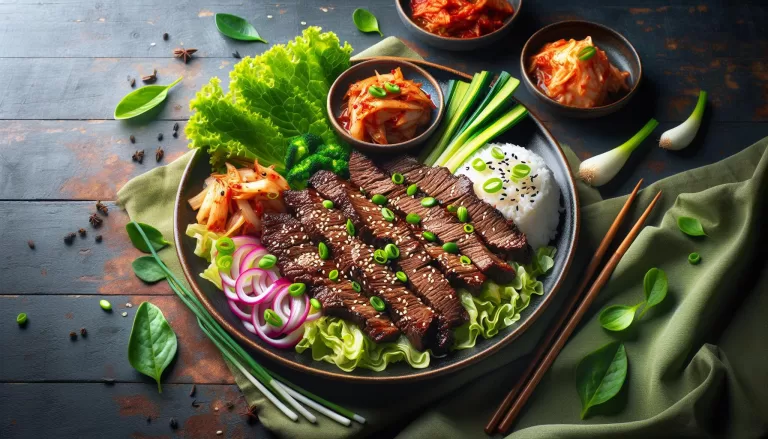Easy Homemade Doraji Namul Salad Recipe and Serving Tips

Ingredients for Homemade Doraji Namul
You’ve decided to take the plunge. It’s time. You’re making homemade Doraji Namul, that delightful, traditional Korean salad made from bellflower root. But what’s on the shopping list? Let’s dive right in.
Doraji Roots: You’ll need 200 grams. Be sure you’re selecting fresh, firm roots for optimal results. The doraji root not only provides a flavorful base but also a wealth of health benefits rich in vitamins and vital minerals like calcium and potassium.
Soy Sauce: A dash, just about a tablespoon, adds the desirable umami to the salad.
Sesame Oil: Yet another integral ingredient, a mere teaspoon is enough to enhance the recipe’s depth.
Garlic: Minced, it imparts a zing. You’ll need about a clove’s worth.
Green Onions: Two stalks, finely chopped, lend a necessary bit of color and crunch.
Red Pepper Flakes: For those who like a little heat, a half teaspoon will do.
Sesame Seeds: Finally, a spoonful sprinkled on top for that perfect finishing touch.
Don’t fret if you’ve got a tough time sourcing doraji roots. They can occasionally be a bit hard to come by in certain areas. Substitute with ginseng, lotus, or even cattail. Each brings unique elements to the dish while still staying true to its original spirit.
The idea is to keep this dish as natural and as close to its roots as possible (pun intended). Hence, the use of fresh, organic ingredients is highly recommended.
Nutritional facts: consider these core ingredients and their primary values per serving:
| Ingredients | Caloric Value | Carbs | Protein | Fat |
|---|---|---|---|---|
| Doraji Roots | 40 Calories | 9g | 1g | 0g |
| Soy Sauce | 10 Calories | 1g | 2g | 0g |
| Sesame Oil | 120 Calories | 0g | 0g | 14g |
| Garlic | 4 Calories | 1g | 0g | 0g |
| Green Onions | 5 Calories | 1g |
Step-by-Step Instructions

Commencing your culinary journey with Doraji Namul begins with preparation. Initiate by soaking the bellflower roots (doraji) for around an hour. This process softens them, making the roots more manageable to clean. Slide your fingers along each root to expel the skin and the dirt that stubbornly clings. Cut the roots into thin slices after a thorough wash.
Next up is seasoning. Place your cleaned and sliced doraji in a bowl; pour in two tablespoons of soy sauce and a tablespoon of sesame oil. Add a teaspoon of minced garlic and a well-chopped bunch of green onions. For that extra flavor spike and radiant color, sprinkle a teaspoon of red pepper flakes. If you’re a fan of that nutty hint sesame seeds provide, top it off with a tablespoon. Mix well.
Then comes the sautéing. Heat your pan over medium-high flame. Introduce your seasoned doraji to the hot pan. Stir-fry the mix for approximately five minutes until the roots become transparent. Keep stirring to avoid burning the seasoning.
For an unorthodox but scrumptious twist, sprinkle a handful of chopped tofus into the pan. This secret ingredient not only amps up the nutritional scale but also harmonizes superbly with doraji’s unique flavor. Sauté an extra two minutes with tofu integrated.
Finally, take your pan off the heat. The enticing aroma of your homemade Doraji Namul woos your senses. It’s ready to serve. If desired, garnish with more sesame seeds and some sliced green onions.
The following table provides a quick recap of your process, breaking it down into simplified steps along with the exact ingredients and their quantities.
| Steps | Ingredients | Quantity |
|---|---|---|
| 1 | Doraji (Bellflower Root) | Enough for serving |
| 2 | Soy Sauce | 2 tablespoons |
| 3 | Sesame Oil | 1 tablespoon |
| 4 | Garlic | 1 teaspoon minced |
| 5 | Green Onions | 1 bunch chopped |
| 6 | Red Pepper Flakes | 1 teaspoon |
| 7 | Sesame Seeds | 1 tablespoon |
| 8 | Tofu | Handful chopped |
Tips for Preparing Bellflower Root

Proper cleaning and preparation are essential when it comes to bellflower root, otherwise known as doraji. First off, you’ll need to soak the roots overnight, as this helps eliminate its bitter taste. Now, let’s break down the process:
- Soak: Grab a large bowl, fill it with water and place your roots in. The root’s outer skin will soften as it absorbs the water, making it easier to peel. Also, it’ll reduce the cooking time.
- Clean: Once soaked, wash each root under cold running water to remove any residue.
- Peel: Using a vegetable peeler or a sharp knife, gently peel off the outer skin – this is where most of the bitterness lies. Be sure to trim off the darkened areas and roots as well.
Here’s a table to capture the essentials:
| Steps | Details |
|---|---|
| Soak | Overnight in a large bowl of water |
| Clean | Wash under cold running water |
| Peel | Use a knife or vegetable peeler to remove outer skin & roots |
Moving forward, let’s talk about slicing. Traditionally, doraji is sliced thinly – think Julianne cuts. This not only makes it easy to chew but also allows for better absorption of flavors during the sautéing process.
The art of seasoning doraji lies in the right balance of ingredients. Your combination of soy sauce, sesame oil, garlic, green onions, red pepper flakes, and sesame seeds should complement not overpower the subtle taste of the root.
Looking for a little twist? Try adding extra firm tofu. Not only does it add a creamy texture to your salad, but it’s also an excellent source of protein!
Now that you have these tips handy, the process of preparing doraji namul should be a breeze. Your end result should be a refreshing bellflower root salad filled with flavor and nutrition.
Serving Suggestions

Having prepared your Doraji Namul, it’s time to think about how to dish it up. This delightful root salad comes to life when paired with the right feeder dishes. Here’s where savvy serving suggestions come handy.
Pair it up Right
Doraji Namul is incredibly versatile. It sits comfortably alongside both vegetarian and non-vegetarian dishes alike. You can serve it with other Korean favorites like Kimchi, Bulgogi or Japchae. For non-vegetarian lovers, try pairing it up with a spicy Korean BBQ ribs or grilled shrimps.
Devour it with Rice
Remember those flavorful juices this salad leaves behind? Steam some rice and those juices will add a delightful punch when the rice soaks it up. Additionally, white or brown rice both work well alongside this salad. If you’re feeling adventurous, use black rice for a distinct contrast in color and a surge in fiber and nutrition.
Award a group dinner
Your Doraji Namul salad is also an impressive addition to a buffet-style meal. Compliment it with a variety of other dishes and watch your guests pile up their plates with this flavorsome, Korean delicacy.
Turn it into a Bento Box
Love lunchboxes? How about turning your Doraji Namul into an exciting Bento Box lunch. Mix a portion of salad with a splash of protein, some steamed veggies, a mound of rice and voila! You’ve just created an enticing lunch that’s easy to carry around and fantastic to eat.
The beauty of Doraji Namul lies in the versatility that it offers. While these are just a few suggestions, don’t limit your creativity. Play around with flavors, mix and match with different dishes and create your unique Doraji Namul experience. After all, it’s all about enjoying yourself and creating memories with every bite.
Health Benefits of Doraji Namul

That tantalizing Doraji Namul you’re recreating isn’t merely a feast for your taste buds. Guess what? It’s also brimming with health benefits.
Bellflower root, or Doraji, is proven to pack a nutritional punch. Key nutrients it contains are calcium, iron, fiber, and vitamin C. These nutrients are essential for maintaining a healthy body. Doraji is also highly appreciated for its anti-inflammatory properties. It’s used traditionally in Korean medicine to treat coughs and other respiratory ailments.
Let’s dive in deeper:
- Calcium: Your bones and teeth will thank you for the extra calcium. It’s crucial for their growth and strength. You’ll also need the mineral for your nerves to function properly.
- Iron: Iron stands as a vital component of hemoglobin. Your body requires it to transport life-giving oxygen to your cells.
- Fiber: High fiber intake aids digestion and prevents constipation. It also keeps your heart healthy by lowering cholesterol levels.
- Vitamin C: A powerhouse antioxidant. It boosts your immune system while simultaneously fighting off damaging free radicals.
Remember, balance is the key. Doraji Namul is a marvelous way of incorporating additional nutrients into your diet. Don’t forget to pair it with a variety of other healthy foods to enhance its benefits.
While crafting this recipe is a gastronomical joy, remember that you’re also getting these substantial benefits from Doraji. Enjoy cooking, savor every bite, and reap the health rewards.
| Nutrients in Doraji | Benefits |
|---|---|
| Calcium | Strengthens bones and teeth, necessary for nerve function |
| Iron | Vital for oxygen transport in the body |
| Fiber | Aids digestion, lowers cholesterol |
| Vitamin C | Antioxidant, boosts immune system |
Don’t let the health benefits of Doraji Namul catch you by surprise anymore. Next time when you stir up this flavorful salad, you know you’re doing a massive favor to your body.
Conclusion
So there you have it. You’re now equipped with all the knowledge you need to whip up a delicious Doraji Namul salad right at home. Remember, the beauty of this dish lies in its versatility. Don’t hesitate to pair it with your favorite Korean dishes or to incorporate it into your Bento Box lunch. The possibilities are endless. And let’s not forget the health benefits. Packed with essential nutrients like calcium, iron, fiber, and vitamin C, this salad is more than just a tasty treat. It’s a powerhouse of nutrition that supports your overall health. But remember, balance is key. Make sure to enjoy your Doraji Namul as part of a varied, nutritious diet. So go ahead, get creative, and start enjoying your unique Doraji Namul experience today.





